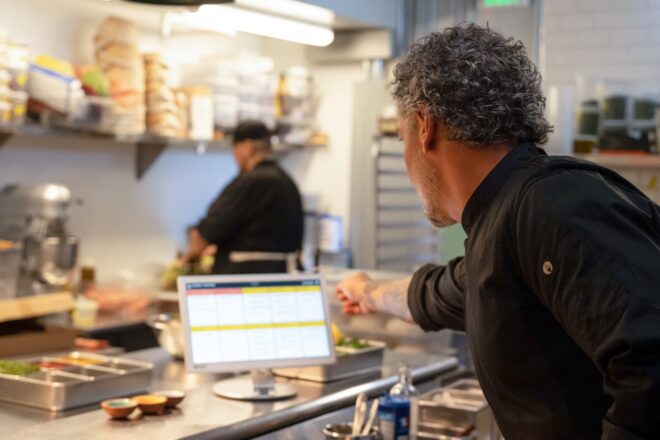Simple restaurant kitchen layout ideas that optimize back of house operations
Editorial Team
6 min read
Designing a streamlined restaurant kitchen floor plan can be challenging. Every decision you make when planning your back of house can affect how people work as well as how many dishes your kitchen can efficiently produce each day.
This in turn makes it important to consider how your back of house kitchen will also impact the overall timing and flow of your dining service. Join us as we look at some common floor plans and recommendations that may help you make the most of your large or small commercial kitchen layout.
Commercial kitchen layout types
Not all commercial restaurant kitchens are created the same. These commercial kitchen layout ideas are all viable options, while some may do a better job of maximizing smaller footprints than others. This can help you make the most out of the space you have.
Assembly line layout
Much like the name suggests, the assembly line layout uses a series of tables and countertops to create a singular flow through the kitchen. This takes dishes going from their station of origin straight through to the expo area where they’ll be whisked off to guests. This layout tends to work best for restaurants that focus on small menus with a lot of similar dishes being prepped, such as a burger bar or pizza parlor.
Island layout
The island layout has one central cooking station or cluster of stations surrounded by other essential areas, such as food prep, the dishwashing zone, and dry storage. This allows the cooks to quickly get ingredients and drop used pots and pans off with ease. And it also enables greater supervision, as the executive chef can circle the island and check in on what’s being prepared and better monitor ticket times.
Zone-style layout
Restaurants that use a zone-style kitchen layout have designated areas for each type of activity that takes place on a regular basis. There will be a cold station for salads and cold appetizers, dessert station, fryer station, meat station, sauté station, and so on.
This layout can be beneficial because there is a clear-cut way to know who should be doing what and where the head chef should look for a particular dish or component of a dish. This design can also help keep ingredients at the correct temperature, while allowing all of the zones to lend themselves to executing large menus at heavy volumes. Small restaurants might struggle with a zoned layout because of the separation, which can require more staff and potentially limit multitasking.
Galley layout
A galley kitchen layout tends to be popular with small restaurants because it can be one of the best ways to transform tight spaces into a workable back of house. With this layout, equipment and cook/prep stations will be located against two parallel walls, placing your team in a back-to-back workflow within the linear environment.
This can lead to some accidental bumps and knocks, but the closeness can also be a major benefit. As your team gets into a rhythm, they’ll be able to cover multiple stations, work with less staff, execute dishes quickly, and pass dishes down the line with impressive efficiency – maximizing the potential of your small restaurant kitchen layout.
Open kitchen layout
An open commercial kitchen setup combines good food and entertainment by allowing diners to see into the kitchen and watch as the dishes they order are prepared for service. You can execute this idea in several ways:
- Create an open kitchen and dining experience by removing the wall separating the kitchen staff preparing dishes from the dining area so that all seated guests can see the behind-the-scenes action.
- Have a bar-like seating area that peeks into the kitchen — in this case, you’d want the kitchen to be big enough that guests aren’t in contact with other diners’ dishes or too close to hot cooking implements.
- Have a partial opening, such as a window, and offer guest seating in the corner of the actual kitchen — this can make for a great VIP experience, though it can be difficult to achieve within a smaller restaurant setup.
Essential components of a commercial kitchen floor plan
As you consider various commercial kitchen design ideas, keep in mind all of the things you need for your ideal restaurant kitchen setup. This can help ensure that you have the ability to cook everything on your menu in tandem with delighting your guests.
Prepping area
Many of your ingredients may need to be prepped. Your team might have to break down primal cuts of beef into steaks and roasts, slice and dice veggies, shred cheese, and more. You will need food prep areas for washing and cutting, as well as adjacent storage for all the tools of the trade.
Cooking area
Sautéing, frying, roasting, broiling, grilling, and searing — it all happens in a restaurant kitchen, and you need both the equipment as well as the space for chefs to work their magic. That means adding stoves, ovens, flat tops, and refrigeration to your chosen layout, as well as integrated storage and workstations.
Restaurant storage
Some equipment will be stored adjacent to the stations it’s used on, but larger items will need to be stored elsewhere. You will need to brainstorm restaurant storage ideas for dry pantry items, such as flour, sugar, salt, and herbs as well as larger refrigerators and freezers for holding raw ingredients before they’re moved to the line.
Keep in mind that you’ll also need a dedicated area for all of your cleaning supplies and chemicals that must be stowed far away from anything that comes into contact with food.
Dishwashing/cleaning area
The dishwashing area in a restaurant is one of the most underappreciated spots. Small restaurant, huge restaurant, any sized diner in between — no restaurant works without clean dishes, cups, cutlery, and cookware. Smaller businesses can possibly get away with a three-compartment sink and drying area, but you might consider upgrading to a dishwashing machine and speed dryer for faster output.
Servicing area
Your service area is where you truly unify the front and back of house. This area usually holds your restaurant POS system as well as utensils, garnishes, and other important items that servers and food runners use to finish off everything the kitchen has created. This might also be where you have to-go containers and disposable silverware for curbside orders and delivery pickups.
Run your own restaurant easier with Clover
Though your restaurant kitchen design plays a major role in determining the efficiency of your day-to-day operations, the right tools can help you grow. From scheduling your staff and managing daily inventory to marketing seasonal specials and using sales data to inform your decisions – Clover’s restaurant POS system can help maximize your operations.
Why wait? Get started with a Clover POS system today to elevate your business.
CONTACT SALESRelated Posts
Restaurants can streamline order management with new Clover Kitchen Display System
Full Service Restaurants (FSR)
Top 5 YouTube channels every full-service restaurant owner should watch
Popular Topics
Stay in touch
Sign up and learn more about Clover.
Thank you for your subscription!
More posts about starting a small business
eBook
Retail roadmap: Financial goal-setting for the year ahead
Please share your contact information
to access our premium content.
Thank you for sharing your contact information.
Download Now





